| |
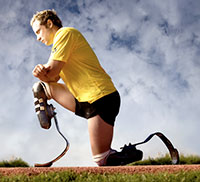
Oscar Pistorius — Ossur
In January 2008, the International Association of Athletics Federation (IAAF) ruled that 21-year-old sprinter Oscar Pistorius was ineligible to participate in international competitions. Their reason: the double-amputee used prostheses that provided him with an unfair edge over non-amputee competitors. IAAF’s decision was based on scientific evidence: the prosthetic blades provided Pistorius with an advantage over non-amputee sprinters with biological ankles; and the prostheses allowed Pistorius to obtain similar speeds as non-amputee racers using less metabolic energy. The ruling sparked a scientific controversy over the advantages and disadvantages of prosthetics in athletic performance. The results of further studies on Pistorius and his Cheetah prostheses refuted those used to support the IAAF decision. They found that prosthetics required more energy to obtain sprinting speeds than biological legs with little evidence that the prosthetics provided Pistorius with a mechanical advantage. Pistorius appealed the ruling to the Court of Arbitration for Sport, which overturned the IAAF decision based on these studies in May 2008.
MIT Gets Into the Act
Dr. Alena Grabowski was part of the team that weighed in on the debate in Pistorius’s favor. She studies the physiology and mechanics of human locomotion at the Massachusetts Institute of Technology with the goal of developing better prosthetics for amputees. Specifically, Dr. Grabowski studies trans-tibial amputees, or amputees who have had an amputation below the knee. “There are many different kinds of prosthetics for different purposes,” explains Dr. Grabowski. “So the prosthetics Oscar Pistorius uses as a sprinter are very different from those used by most other amputees.” In fact, large populations of trans-tibial amputees are older folks who have lost limbs because of diabetes.
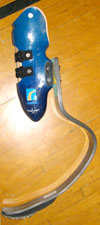
Cheetah Prosthesis —
Dr. Alena Grabowski
Evolution of Prostheses
The most basic type of trans-tibial prosthetic is a simple spring that stores and returns elastic energy and is similar to a biological ankle joint. While this traditional design provides some basic functionality for an amputee, it is problematic because it requires the amputee to expend much more energy to accomplish the same activities as non-amputees. In other words, the metabolic cost of, or energy required for, performing daily activities for amputees has increased. This is because the prosthesis can only store energy whereas a biological ankle and the surrounding calf muscles actually provide power to push the walker forward. If the right amount of power were added at the proper time to a prosthesis, however, it may be possible to reduce the metabolic cost of walking for the amputee. Dr. Grabowski hopes to aid in the development of a prosthesis that is more like natural walking by comparing the prosthetics already available on the market to a newly developed powered prosthesis.
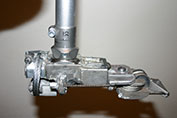
K3 Promoter Prosthesis — Tensegrity
Prosthetics, Inc.
There are many types of prostheses currently available to an amputee that can be broadly classified into 3 categories. First, the traditional passive-elastic spring that stores and returns energy but cannot generate energy. Second, the K3 Promoter is a passive elastic foot that has an ankle joint and is able to mimic natural walking in terms of stiffness and elasticity. Although the K3 Promoter cannot provide power like a biological ankle, the K3 feels more like a biological foot and improves amputees' metabolic energy cost at slow walking speeds. More recently, the MIT Biomechatronics group and the Providence VA Medical Center's Center for Restorative and Regenerative Medicine have developed the PowerFoot, a prosthetic foot and ankle which actually provides power more like a biological ankle. This is the prosthetic Dr. Grabowski is currently testing in her laboratory.
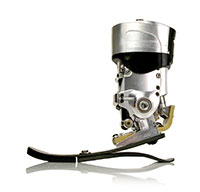
Powered Prosthesis — iWalk, Inc.
Dr. Grabowski conducted experiments with a group of amputee participants and a group of non-amputee participants as experimental controls. She measured the amount of oxygen consumed and carbon dioxide produced during a given activity to determine metabolic cost to the participant. She also measured muscle activity using electrodes on the skin and the forces exerted by the participants' movements using force-plates that are embedded in the ground. Additionally, Dr. Grabowski placed reflective markers on the joint centers of participants who were photographed using sophisticated video cameras for later analysis of movement. Based on the most recent results from these experiments, Dr. Grabowski predicts that using the PowerFoot will allow unilateral amputees to achieve more symmetrical walking. With the addition of power at the ankle, amputees using the PowerFoot should be able to decrease the metabolic cost of walking. And that is great news for amputees seeking to regain their quality of life.
Dr. Alena Grabowski is a post-doctoral fellow at the Biomechatronics Group at the Massachusetts Institute of Technology. She received her Ph.D. from the University of Colorado, Boulder in integrative physiology. “My passion for human physiology and locomotion stems out of my passion for sports,” Dr. Grabowski explains. Dr. Grabowski is an avid trail-runner and skier and loves to be outdoors in the mountains whenever she can.
For more information:
- Grabowski, A. and H. Herr. 2009. “Leg exoskeleton reduces the metabolic cost of human hopping.” Journal of Applied Physiology: 670-678.
- Grabowski, A., J. Rifkin, and R. Kram. 2010. “K3 Promoter Prosthetic Foot Reduces the Metabolic Cost of Walking for Unilateral Transtibial Amputees.” Journal of Prosthetics and Orthotics: 113-120.
- Grabowski, A. et al. 2009. “Running-specific prostheses limit ground-force during sprinting.” Biology Letters: 201-204.
To Learn More:
- Amputee Coalition of America. http://www.amputee-coalition.org/
- American Physiological Society. http://www.the-aps.org/
- American College of Sports Medicine. http://www.acsm.org/
- Oscar Pistorius’s Website. http://www.oscarpistorius.co.za/
Written by Rebecca Kranz with Andrea
Gwosdow, Ph.D. Gwosdow
Associates
HOME | ABOUT | ARCHIVES | TEACHERS | LINKS | CONTACT
All content on this site is © Massachusetts
Society for Medical Research or others. Please read our copyright
statement — it is important. |
|
| 
Dr. Alena Grabowski
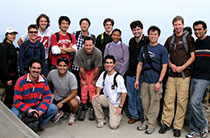
MIT Biomechatronics Group
Related Videos:
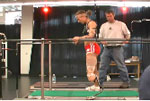
Sprinting

Ankle Walking
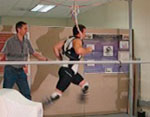
Oscar Sprinting
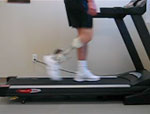
Powerfoot Walking

Bones
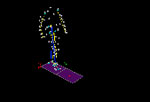
Walking
Sign Up for our Monthly Announcement!
...or  subscribe to all of our stories! subscribe to all of our stories!

What A Year! is a project of the Massachusetts
Society for Medical Research.
|
|

